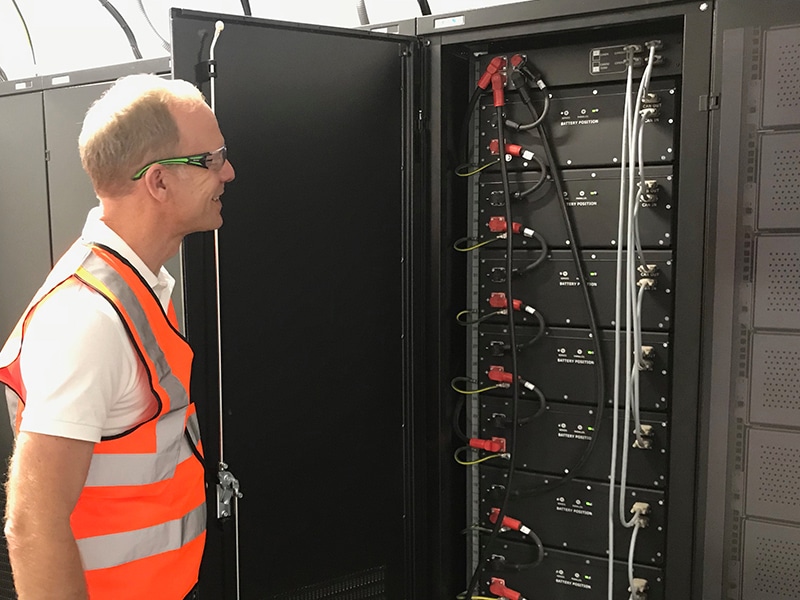
Hans Eric Melin inspecting second life batteries from Nissan Leaf at an Eaton plant in South Africa
So what are they doing with those batteries, bury them, I guess?
A relaxed chat by the football pitch or an emotional rant on Twitter about the dark side of the EV. It doesn’t matter, people’s general perception about battery recycling is almost always the same – We suck, don’t we?
It’s not only batteries. Stories about western countries dumping waste either in our own backyard or in developing countries are extremely sticky and few people question the logic that waste products which contain valuable materials, or which sometimes even are good for further use, would be sent to be dumped. Who would pay for that to happen? And why?
In a typical 40 kWh electric car battery there are about 800 Pounds worth of materials, only from the cells. Usually that’s not the kind of money we would throw away is it? Still many companies actually pay for the batteries to be recycled, sometimes as much as 1200 Pounds per battery.
How can this be?
Well, between the owner of the battery and those 800 Pounds is of course a fair amount of work. The tear down of the large pack and the process to separate the materials in the cells will obviously consume both time and money.
And as we have to pay for the battery to be recycled most people draw the conclusion that the costs for recycling are higher than the value of the recovered materials and for that to change we need more and better recycling technology.
However, that is not really true. What we really need is more batteries to recycle.
In an episode of the Belgian comic series Lucky Luke, the cowboy who shoots faster than his own shadow, there is a wonderful opening scene about a farmer who just bought some new land and discovers that it’s drained in oil: “I’ve been tricked with this land! It’s full of oil!”. I think that’s a great reminder about where we are today. A piece of raw material only has a value if it can be efficiently extracted and refined – and if it has a buyer.
In Europe a couple of thousands battery packs from cars and buses will reach their end of life this year. Those packs come from different brands and models, are scattered on different markets and will come in very different conditions. It’s hard to make anything efficient with that kind of volume. To prepare an EV battery for recycling it has to be disassembled at least down to module level (a Tesla pack consists of 16 modules with 444 cells each) and often down to cell level. Battery packs differ widely in design and it takes time for operators to learn to disassemble each type. Although the process could be automated it’s currently impossible to justify only because there aren’t enough batteries. Hence it is usually very expensive.
Fast forward a few years and this has changed tremendously. Thousands of packs have become tens of thousands which will enable recycling companies to invest in expertise and technology to make everything from disassembly to recovery of materials more efficient. From having been a cost, recycling can now become a revenue of which some will be transferred up to the battery owners who also will have plenty of recyclers to choose from which all with compete to get hold of material.
However there are a few problems
First of all it’s not certain that the batteries will stay here. Lithium-ion batteries have already been recycled for many years. In your laptop, smartphone, portable speaker or power tools there are lithium-ion batteries. While some of these have been recycled in Europe many of them have been exported to recyclers in Asia. Sometimes as batteries but often in the form of so called black mass which basically contains the active materials from the batteries after organic materials and solid metals have been separated by recyclers in Europe. A significant amount of batteries are also leaving Europe contained in devices such as smartphones and tablets as there is a huge market in China where these devices are refurbished and sold again to mobile phone shops around the world. However, the batteries in the devices go to recyclers in China. It’s also in China and South Korea where most batteries are made. That means that it’s here the customers are, eager to buy the material from recyclers.
Altogether this has given the recyclers in China and South Korea huge benefits and they are today leading the game. Several Chinese battery material companies in fact started as recycling companies, many times with batteries from Europe and North America as raw material. Their processes are efficient, big and, most importantly, have been operated in many years with large networks of buyers around the world. That enables them to pay more than anyone else to get hold of the batteries. In fact, in China, all recyclers are paying for batteries to recycle. Even LFP batteries which contains neither cobalt or nickel are payed for. The competition is already tough and the current capacity is in fact enough to serve China’s need in 2025 and beyond.
Secondly most of the batteries that reach end of life will neither go to China or to European recyclers. Increasingly when EV batteries are removed from a vehicle they are assessed for remanufacturing and repurposing. Remanufacturing means that they once again will serve as batteries in cars after one or a few modules have been replaced. Repurposing means that they will be used for other tasks such as energy storage in commercial buildings or supporting the grid. This market is growing rapidly, especially in Europe and China, with several energy storage companies starting to use so called second life batteries. This means that the recycling of these batteries will be delayed at least five and sometimes as much as ten years.
It’s also reuse of batteries that many times keep the volumes from taking off in the short run as the attractiveness, especially for a few battery models, are very popular among Do-It-Youselfers and smaller companies which turn classical cars to EV’s or make their own energy storage systems. That’s why a 5.2 kWh Tesla module can go for more than 1000 Pounds on Ebay today.
So for anyone who is worried about lack of recycling capacity in Europe, don’t be. We already have more than we need. Dealing with end-of-life batteries will be a huge business the coming years but it will take time until the actual recycling of the batteries will reach significant scale. The question is rather how British and European companies will be able to take a significant market share.
And if somebody suggests that the batteries will be buried and there is no way to recycle them…, well, tell them that they most probably have recycled battery materials in their smartphone already and that burying even a completely dead EV battery is like burying 2 tonnes of gold ore or 18 barrels of crude oil.
About Hans Eric Melin
Hans Eric Melin is consultant and analyst at Circular Energy Storage specialised in lifecycle management of lithium-ion batteries. He is author to several reports for organisations and governments on end-of-life management of lithium-ion batteries and is the main contributor to Circular Energy Storage’s quarterly report “The lithium-ion end-of-life market”. Originally from Sweden, Hans Eric is based in London, www.circularenergystorage.com.





